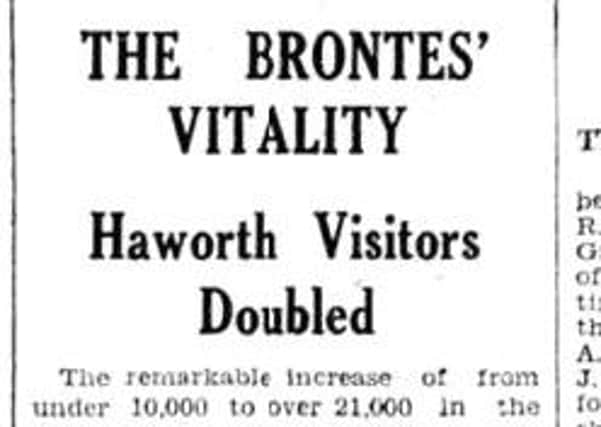On this day in Yorkshire
This article contains affiliate links. We may earn a small commission on items purchased through this article, but that does not affect our editorial judgement.


April 9, 1945
The remarkable increase of from under 10,000 to over 21,000 in the number visitors to the Bronte Parsonage Museum at Haworth last year was referred to at the 51st annual meeting of the Bronte Society, held in the Leeds Civic Hall on Saturday.
Mr Donald Hopewell (President), who presided, said he thought this was almost the most encouraging thing that could have happened. The increase was partly due the fact that because, with transport difficulties, people could not go far afield at present, and more people than formerly were compelled to learn something about their own neighbourhood. Another reason was the very large number of men and women in the Forces who, in their leisure hours, had visited the Museum. It all showed how great was the interest taken in the life and work of the Brontes.
Advertisement
Hide AdAdvertisement
Hide AdA satisfactory financial statement was presented by Dr W.M. Dickie, the hon treasurer, who said the receipts from Museum admission fees had Increased from £252 in 1943 to £520 last year. The total cash assets of the Society were £1,651, as against £1,237 at the end of 1943, an increase of £414.
Reviewing the work of the Society during the year, Mrs C. Mabel Edgerley (hon secretary) said they had added many new members. She also referred to interesting gifts which had been made to the Society.
Mr W.L. Andrews, hon editor of the Transactions of the Society, and chairman of the Council, reported how paper and printing labour difficulties had been overcome in producing the Transactions, mainly through the efforts of Mr H. Outhwaite.
Mr Wyndham T. Vint (hon curator of the Bronte Museum), after referring to the record number of attendances, dealt with the question of the reopening of the Bonnell Collection. Now that war risks were very much reduced, he hoped it would be possible to reopen the Bonnell Room during the current year.
Advertisement
Hide AdAdvertisement
Hide AdAfter discussion, it was decided to authorise the Council to reopen the Bonnell Room at the earliest possible date.
A suggestion was made by Mrs Blundell Heynemann that the Society should celebrate Victory Day by the public dedication of the memorial in Westminster Abbey to the three sisters. Mr. Hopewell said that the Dean of Westminster had promised that as soon as circumstances were normal, arrangements could be made for the dedication of the memorial.
Efforts would be made to arrange for this to be as near Victory Day possible.
Mrs. Blundell Heynemann, Mrs Blackburn and Mrs C.V. Walker were added to the list of vice-presidents, and vacancies on the Council were filled by the election of Dr S Edgerley, Mrs Weir, Mr W. T. Oliver, and Mr H. M. Raleigh.
Advertisement
Hide AdAdvertisement
Hide AdAt a subsequent public meeting. Desmond MacCarthy gave an address on “ The Brontes.” The Lord Mayor Leeds (Alderman C. V. Walker), who was accompanied by the Lady Mayoress (Mrs. Walker), presided.
Mr MacCarthy remarked that the fame of some books was accompanied by an intense interest in their authors, and this was particularly true of the Brontes. There were works both in verse and prose which aroused this extremely keen interest in the authors. Byron and the Brontes were prime examples in English literature of arousing this kind interest.
It was striking how a very large part of modern criticism, no doubt from the middle of the 19th century onwards, had consisted in trying to bring the writer, the man or woman behind the work, closer to our imagination.
He thought himself that this had even been overdone. Every writer had to win our confidence in what we might call his sincerity, or the genuineness of his insight and feelings, and it was particularly true of the Brontes that they had done this.
Advertisement
Hide AdAdvertisement
Hide AdOne of the greatest overwhelming merits of the Brontes was that one felt that what they wrote belonged most intimately to them.
Mr MacCarthy drew attention to point which had not, he thought, been sufficiently or clearly enough emphasised. Whereas we could trace very close connections between the work of Charlotte and of Anne and their experiences, in the case of Emily there was an enormous gap, which not only no records, but really plausible conjecture, could bridge.
Emily’s genius was for the representation of what might be called pure passion. She felt rather than observed. Charlotte felt through experience and through observation. Emily’s “Wuthering Heights” was the creation of pure imaginative passion.
After speaking of what the sisters had done to assert the spiritual rights and equalities of their sex, Mr MacCarthy said that their work, in its content, was a splendid imaginative statement of the claims the emotional life of woman.
Advertisement
Hide AdAdvertisement
Hide AdThanks to Mr MacCarthy and the Lord Mayor wore accorded on the motion of Mr Hopewell seconded Mr Andrews.
To browse our historic pages online visit the British Newspaper Archive